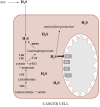Postbiotics, Metabolic Signaling, and Cancer
- PMID: 33799580
- PMCID: PMC8000401
- DOI: 10.3390/molecules26061528
Postbiotics, Metabolic Signaling, and Cancer
Abstract
Postbiotics are health-promoting microbial metabolites delivered as a functional food or a food supplement. They either directly influence signaling pathways of the body or indirectly manipulate metabolism and the composition of intestinal microflora. Cancer is the second leading cause of death worldwide and even though the prognosis of patients is improving, it is still poor in the substantial part of the cases. The preventable nature of cancer and the importance of a complex multi-level approach in anticancer therapy motivate the search for novel avenues of establishing the anticancer environment in the human body. This review summarizes the principal findings demonstrating the usefulness of both natural and synthetic sources of postbotics in the prevention and therapy of cancer. Specifically, the effects of crude cell-free supernatants, the short-chain fatty acid butyrate, lactic acid, hydrogen sulfide, and β-glucans are described. Contradictory roles of postbiotics in healthy and tumor tissues are highlighted. In conclusion, the application of postbiotics is an efficient complementary strategy to combat cancer.
Keywords: GPR81; SCFA; colorectal cancer; functional food; intestinal metabolome; microbiome.
Conflict of interest statement
The authors declare no conflict of interest.
Figures




Similar articles
-
Probiotics and postbiotics in colorectal cancer: Prevention and complementary therapy.World J Gastroenterol. 2022 Jul 21;28(27):3370-3382. doi: 10.3748/wjg.v28.i27.3370. World J Gastroenterol. 2022. PMID: 36158273 Free PMC article. Review.
-
Postbiotics-A Step Beyond Pre- and Probiotics.Nutrients. 2020 Jul 23;12(8):2189. doi: 10.3390/nu12082189. Nutrients. 2020. PMID: 32717965 Free PMC article. Review.
-
The Effect of Probiotics on the Production of Short-Chain Fatty Acids by Human Intestinal Microbiome.Nutrients. 2020 Apr 16;12(4):1107. doi: 10.3390/nu12041107. Nutrients. 2020. PMID: 32316181 Free PMC article. Review.
-
Microbial Metabolites, Postbiotics, and Intestinal Epithelial Function.Mol Nutr Food Res. 2021 Mar;65(5):e2000188. doi: 10.1002/mnfr.202000188. Epub 2020 Oct 11. Mol Nutr Food Res. 2021. PMID: 32992407 Review.
-
Gastrointestinal Interaction between Dietary Amino Acids and Gut Microbiota: With Special Emphasis on Host Nutrition.Curr Protein Pept Sci. 2020;21(8):785-798. doi: 10.2174/1389203721666200212095503. Curr Protein Pept Sci. 2020. PMID: 32048965 Review.
Cited by
-
Role of microbiota and microbiota-derived short-chain fatty acids in PDAC.Cancer Med. 2023 Mar;12(5):5661-5675. doi: 10.1002/cam4.5323. Epub 2022 Oct 7. Cancer Med. 2023. PMID: 36205023 Free PMC article. Review.
-
The Influence of Nutrition on Intestinal Permeability and the Microbiome in Health and Disease.Front Nutr. 2022 Apr 25;9:718710. doi: 10.3389/fnut.2022.718710. eCollection 2022. Front Nutr. 2022. PMID: 35548572 Free PMC article. Review.
-
Local and systemic effects of microbiome-derived metabolites.EMBO Rep. 2022 Oct 6;23(10):e55664. doi: 10.15252/embr.202255664. Epub 2022 Aug 29. EMBO Rep. 2022. PMID: 36031866 Free PMC article. Review.
-
Benefits and concerns of probiotics: an overview of the potential genotoxicity of the colibactin-producing Escherichia coli Nissle 1917 strain.Gut Microbes. 2024 Jan-Dec;16(1):2397874. doi: 10.1080/19490976.2024.2397874. Epub 2024 Sep 4. Gut Microbes. 2024. PMID: 39229962 Free PMC article. Review.
-
Initiation of Apoptotic Pathway by the Cell-Free Supernatant Synthesized from Weissella cibaria Through In-Silico and In-Vitro Methods.Appl Biochem Biotechnol. 2024 Jul;196(7):4700-4724. doi: 10.1007/s12010-023-04688-3. Epub 2023 Sep 26. Appl Biochem Biotechnol. 2024. PMID: 37751008
References
Publication types
MeSH terms
Substances
Grants and funding
LinkOut - more resources
Full Text Sources
Other Literature Sources
Medical

